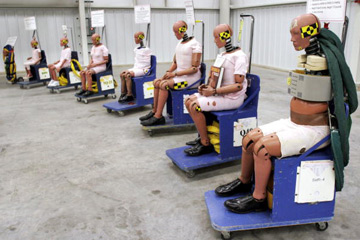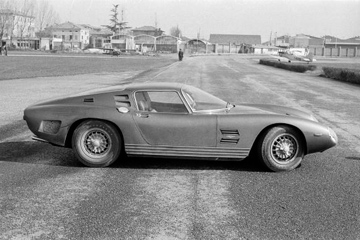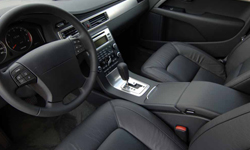 Image Gallery: Concept Cars Proving grounds give General Motors the space it needs to test (in private) experimental vehicles, like this 1954 gas turbine-powered vehicle, the XP-21 Firebird. See more pictures of concept cars.
Image Gallery: Concept Cars Proving grounds give General Motors the space it needs to test (in private) experimental vehicles, like this 1954 gas turbine-powered vehicle, the XP-21 Firebird. See more pictures of concept cars.
There's a good chance that you drive (or at least ride in) a car every day. You may have a family that rides in that car with you. And chances are that you trust that car to keep you and your family safe. Even under unusual driving conditions -- weird weather, high speeds, bumpy roads, accidents -- you expect your car to respond well and protect you and your loved ones. After all, the manufacturer has advertised the car as having certain capabilities and being safe to drive.
But how, exactly, does the manufacturer know that? How do the people who built your car know exactly what conditions it can stand up to? Did they drive it through all possible road conditions under all possible circumstances just to be sure?
Well, yes, they did. Before a car is put on the market, it has to be tested in extreme conditions to make sure that no manufacturing defects or design miscalculations will cause it to be unsafe or behave in unpredictable ways. Every now and then, of course, we hear of a car being recalled because of some unexpected defect, like sudden acceleration or exploding on impact, but these things are quite rare. Most cars behave exactly the way they're supposed to, at least the great majority of the time.
Where do manufacturers test their cars to be sure they work as advertised? Almost every major auto manufacturer has an automotive proving ground, a place where they can take cars and put them through paces, testing them rigorously against extreme and varying conditions at different speeds with varying passenger loads. These proving grounds have a long history, dating back the better part of a century. Some of the most colorful episodes in automotive history have taken place at these testbeds of automotive technology, but most of us will never know about them.
So, where exactly are these proving grounds and what do the automakers do there? This isn't exactly a secret. Nonetheless, most manufacturers don't go out of the way to let people know what goes on in their private testing facilities. Volkswagen even likes to think that its test track is secret (but we know better). In the rest of this article, we'll look at the history of automotive proving grounds and just what it is that companies from GM to Fiat do there.
 The new Iso Grifo A3 during testing at the Modena Aerautodromo, 1964.
The new Iso Grifo A3 during testing at the Modena Aerautodromo, 1964.
Until the 1920s, automotive testing was done in the same place as most automobile driving -- on city streets and country roads. But as the automobile became an increasingly important mode of transportation and the roads filled with cars, this ceased to be feasible. It was too dangerous to test cars in public places. Furthermore, auto manufacturers became wary of letting the public see their cars while they were still in the testing phase. Competitors might have a chance to steal trade secrets or journalists might get too close a look at future models.
In 1924, General Motors opened the Milford Proving Grounds in what was then a fairly isolated portion of Michigan. It was the world's first dedicated automotive proving ground. The original site consisted of a gravel loop just under 4 miles (6.4 kilometers) in circumference, plus a straightaway. The entire facility was only 1,125 acres (4.6 square kilometers) in size and only a single employee worked at the proving grounds full time. His name was Ruggles Simcock. He was the maintenance superintendent at the facility.
In 1928, GM printed a pamphlet about the Milford Proving Ground that clearly stated the rationale behind it: "No other industry has gone forward so swiftly with so few basic facts -- facts that are needed if the motor car is to be of increasing usefulness to a greater number of people. If the industry is to continue its rate of progress it must know more facts about the material used, the economics of design and what happens as the car is being operated mile after mile upon the road in the hands of the use. To get these facts, General Motors five years ago decided to establish a proving ground and to make it the most comprehensive undertaking of the kind in the world" [source: GM Heritage Center].
This rationale wasn't lost on other auto manufacturers. In 1925 Ford opened its own proving ground in Dearborn, Mich., and the same year Packard built a proving ground in Shelby Township, Mich. By the mid-1920s, rural Michigan was a hotbed of automotive test tracks.
Now, almost every auto manufacturer has at least one such proving grounds and some have several. Nissan has one in Tochigi Prefecture, Japan. Chrysler has one in Yucca, Ariz., which it purchased in 2007 from the Ford Motor Company, and another in Chelsea, Mich. And what's happened over the years to GM's Milford Proving Grounds? It's grown. It now covers 4,000 acres and has 132 miles (212.4 kilometers) of road. There are multiple tracks, in all shapes from straightaways to loops. There's also a vehicle dynamics testing area (VDTA) known as Black Lake, a 67-acre expanse of blacktop where cars can be driven at top speeds and tested under varying surface conditions. Alas, rural Michigan isn't as rural as it used to be and GM has periodically considered selling the site, which is now surrounded by modern development. Although this would represent the loss of an historic facility, GM can make do without it. The company has additional proving grounds in Arizona, Mexico, Brazil, Australia, England, Brazil and Germany. And there are plenty of independent automotive testing centers that would be happy to pick up the slack.
So what are these testing facilities like? On the next page, we'll take a look at a typical automotive proving ground and talk about what goes on there.
 Crash test dummies sit on display at General Motors' new $10 million crash testing center in Milford, Mich. GM announced that rollover air bags will be standard equipment in all its vehicles by 2012.
Crash test dummies sit on display at General Motors' new $10 million crash testing center in Milford, Mich. GM announced that rollover air bags will be standard equipment in all its vehicles by 2012.
A typical automotive proving ground looks like a combination of a military base and an amusement park. From the air, a facility like GM's Milford Proving Ground consists of loops and whorls, straight lines and circles, as though it were a neighborhood that had been designed by a drunken suburban planner. But don't take our word for it. Take a look at it yourself on Google Maps. That big black mass in the upper right is GM's Black Lake vehicle dynamics testing facility, which looks exactly like its namesake -- a jet black lake of asphalt. Closer up, it can appear almost as wet as a lake. Sprinklers are used to water down the surface to test the behavior of vehicles on slippery, low-friction surfaces.
This is the place to go if you want to see cars tested to destruction. (Test vehicles are retired from service when they get too beat up to drive.) It's also the place to come if you want to drive as well as the car testers do. GM instructors teach a course in advanced driving skills at the facility, where you can learn how to get an out-of-control skid back under control or how to deal with an unexpected tire blowout. An obstacle course features just about every hazard that a car is likely to handle under anything resembling normal use, right down to hills, a gravel pit and a phony railroad that crosses the driver's path.
Several test tracks are available. There's the Oval Track, the Circle Track, the North/South Straightaway and the East/West Straightaway, all of which look exactly like their names imply. The Seven Sister course is short yet features seven curves, which test the ability of a car to take tight corners without going out of control or running off the roadway.
There are several special testing facilities. The Vehicle Safety and Crashworthiness Laboratory (VSCL) lets GM test car rollover and the effectiveness of air bags. In one test, cars run along a corkscrew ramp, do a mid-air flip and crash land. (Don't try this at home.) Mostly, though, the tests consist of smashing cars at high speeds against solid walls. Needless to say, this is where the crash tests dummies hang out, including one that specifically simulates a pregnant woman. Its name is the Maternal Anthropomorphic Measurement Apparatus version 2B -- or just MAMA2B.
Don't go to the Milford Proving Grounds to catch a glimpse of upcoming GM cars, though. The vehicles are often deliberately disguised, wrapped in plastic or wearing masks on their front ends so that their lines aren't visible. This prevents paparazzi from the auto press (or just nosy gearheads) from snapping photos of the cars before GM officially announces them.
The GM Milford Proving Grounds is only one of many such proving grounds around the United States and the world, of course. Most others, however, have similar equipment, tracks and facilities, with variations. For instance, Volkswagen's testing facility in Ehra Lessien, Germany, has a straight track so long that, when viewed from one end looking toward the other, it seems to disappear over the horizon. Volkswagen likes to pretend that its proving grounds are secret, but you can look at it from the air via the Web. Fiat's Circuito di Balocco track in Balocco, Italy, was designed for testing Alfa Romeos, but it's now open to other automakers with vehicles to test and also can be used for auto racing.
These proving grounds are home to some of the wildest automobile action on earth. But it's all done in the name of making cars safer and more secure for ordinary people to drive.
For more information about automotive safety and other related topics, follow the links on the next page.

Sources